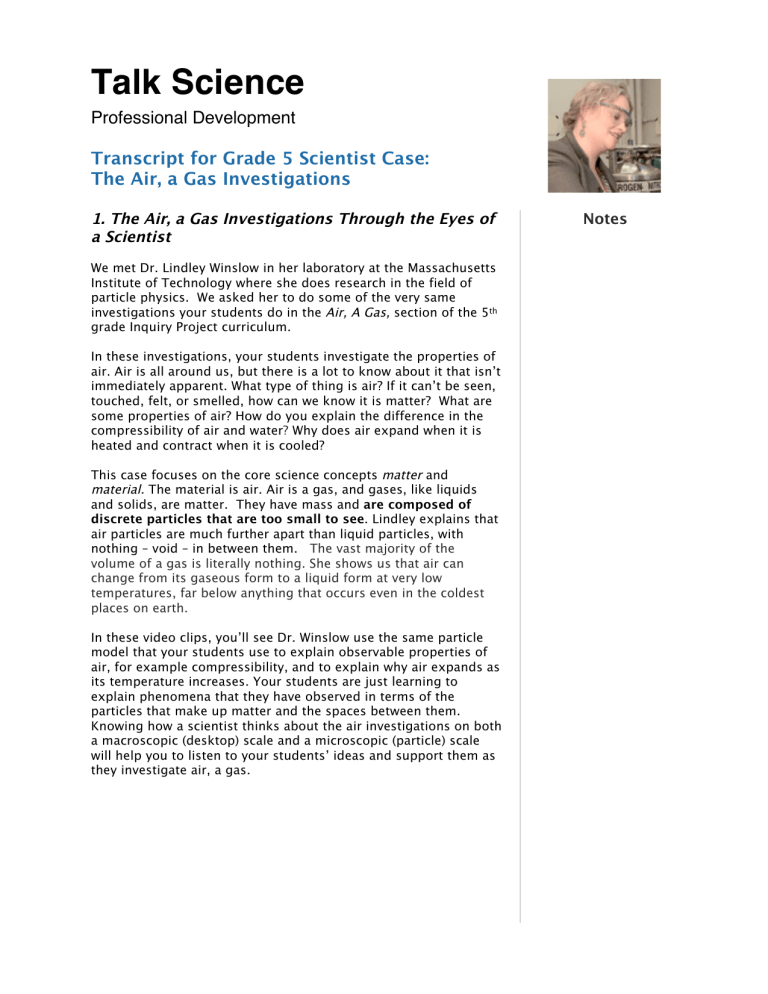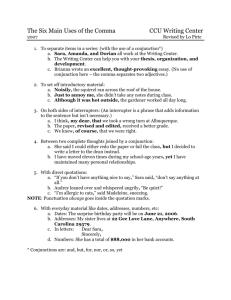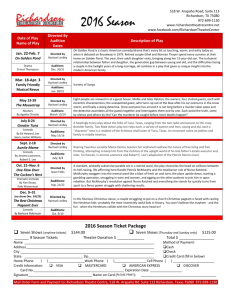Video Transcript
advertisement

Talk Science Professional Development Transcript for Grade 5 Scientist Case: The Air, a Gas Investigations 1. The Air, a Gas Investigations Through the Eyes of a Scientist We met Dr. Lindley Winslow in her laboratory at the Massachusetts Institute of Technology where she does research in the field of particle physics. We asked her to do some of the very same investigations your students do in the Air, A Gas, section of the 5th grade Inquiry Project curriculum. In these investigations, your students investigate the properties of air. Air is all around us, but there is a lot to know about it that isn’t immediately apparent. What type of thing is air? If it can’t be seen, touched, felt, or smelled, how can we know it is matter? What are some properties of air? How do you explain the difference in the compressibility of air and water? Why does air expand when it is heated and contract when it is cooled? This case focuses on the core science concepts matter and material. The material is air. Air is a gas, and gases, like liquids and solids, are matter. They have mass and are composed of discrete particles that are too small to see. Lindley explains that air particles are much further apart than liquid particles, with nothing – void – in between them. The vast majority of the volume of a gas is literally nothing. She shows us that air can change from its gaseous form to a liquid form at very low temperatures, far below anything that occurs even in the coldest places on earth. In these video clips, you’ll see Dr. Winslow use the same particle model that your students use to explain observable properties of air, for example compressibility, and to explain why air expands as its temperature increases. Your students are just learning to explain phenomena that they have observed in terms of the particles that make up matter and the spaces between them. Knowing how a scientist thinks about the air investigations on both a macroscopic (desktop) scale and a microscopic (particle) scale will help you to listen to your students’ ideas and support them as they investigate air, a gas. Notes Talk Science: Grade 5 Scientist Case, The Air, a Gas Investigations: Transcript -- Page 2 2. How Does a Scientist Think about Properties of Air? Notice how Lindley uses the microscopic (particle) perspective to explain properties of air, such as density and compressibility. Sara: I have two syringes here. One is filled with air and one is filled with water. Would you tell me about these two materials and how you look at them from a scientist’s perspective? Lindley: So the difference between a gas and a liquid, of course, is the weight per volume. Gas, of course, much less weight per volume than the liquid. One of the most interesting properties of gas is, of course, just with my own strength, I’m able to compress it and actually reduce its volume by almost a factor of two, just with my own strength. Versus the liquid, or water, here. You know, I am not a complete weakling but I can’t get that to compress any more than it’s already compressed in the syringe. Now, if we’re thinking about our gas a little bit more – this gas is air and I know that air is a mixture of gases itself. It’s mainly nitrogen with about 20% of oxygen, which of course is what we breathe. And then trace amounts of other gases. Sara: The students in the fifth grade Inquiry Project use the particle magnifier to look at air on a different scale – on a particle scale. I’m wondering if you would tell us what you see when you look at this particle magnifier. Lindley: So I see the particles that make up air bouncing around. And in this case, the particles are representing the molecules, so nitrogen molecules most likely for the air and water molecules of course are the red ones bouncing around. The particles themselves cannot get larger or smaller but they can expand to take up more space. So, if you like open up the container you have them in they’ll expand and take up the space of that container cause they’re a gas; that’s what gases do. Sara: So how can we use a model like this to explain some of the experiences we have with air at a macroscopic scale – for instance the fact that we can walk through air, or that air is transparent or… Lindley: Right. So we were talking a little bit, you asked me what is between these little green balls that are moving around on our particle magnifier, and I said nothing. And it is because there is so much nothing between these particles, it’s easy for us to move through it. Versus if we were to look and try to magnify the water, there’s not that much space for us to move around. We’re always Notes Talk Science: Grade 5 Scientist Case, The Air, a Gas Investigations: Transcript -- Page 3 going to be bumping into our particles. And that’s sort of how you can make that bridge between our little particles moving around and what exactly is between them. Sara: How about something like a property like the compressibility? We saw the air was so compressible. Does this particle model help us explain that? Lindley: Yes, exactly. We have these particles moving around and that fact that there is sort of this space between them, you know, allows us to more easily push them back together, if we have sort of enough energy or enough strength to actually do it. Summary • Air is a mixture of gaseous materials composed of particles too small and spread apart to see. • The relative compressibility of air and water can be explained in terms of the configuration of their particles. 3. How Does a Think about Thermal Expansion of Air? Listen to Lindley explain why air expands when it is warmed and contracts when it is cooled in terms of the motion of particles. Sara: I have a bottle of air here, and I’ve made it a closed system by putting a bubble on top of it. And I’m wondering what you think will happen to the air inside the bottle if I heat it up. Lindley: So if the air heats up, since it’s a gas and there are no other forces pulling it in, it’s going to expand. And so I think what’s going to happen is that if you heat up the gas in this bottle, it’ll expand. And because the sides of this bottle are very rigid, air won’t be able to push on that very easily and so it’ll actually just blow a bubble out the top. Because you put that nice bubble film there. Sara: Can we see what happens? Lindley: Sure let’s see. So, heating up the bottle. And look at that. We have a nice bubble forming. So, the gas expands. And it does have less mass per volume. And so one would think that maybe, all of the gas left the bottom of the bottle and pushed up to the top but then how would you be keeping the bottom of the bottle from collapsing in on itself, if all of the air just left down there. So since we see that the bottom of the bottle is still, you know, perfectly fine in shape – that really leaves the option that all of the gas in this expanded equally and is now having to push out over the top of the bottle. Notes Talk Science: Grade 5 Scientist Case, The Air, a Gas Investigations: Transcript -- Page 4 Sara: So if you put the bottle in on its side, the bubble would still grow? Lindley: I think so. Maybe not as well. There it goes! So yeah you’ll notice that the bubble isn’t asymmetric or anything, so it’s not just that it’s all rising from the bottom and going out the top. It’s really pushing equally all the way around. Sara: So what happens if you put it in cold water? Lindley: Well then the gas will get cooler. It’ll contract and the bubble will shrink. Cool it down; bubble goes away as the gas contracts. Sara: Oh, look at that. Lindley: Oh look at that. It’s complete reversal. We can have an internal bubble. Aw, experiments are fun. Sara: How does this particle model help us explain why air expands when it’s warm and contracts when it’s cold? Lindley: So we’re modeling our air as these little balls, and so as they get warmer – let’s move up from two to twenty – their speed increases and they’re able to sort of push out and they’re able to move farther and push away, push away quicker or harder. And so as you move up in temperature you can see that, you know, given a warm gas and you throw it into an empty room, that these really fast particles are going to spew out and really fill the space very quickly. Versus our much slower, colder particles are going to expand much slower. Sara: So, the same number of particles take up more volume when it’s hotter? Lindley: Right. Sara: At a hotter temperature. Lindley: Right. Summary • When the temperature is higher, the particles move faster and they bump into each other more often and move farther apart making the air take up more space. Notes Talk Science: Grade 5 Scientist Case, The Air, a Gas Investigations: Transcript -- Page 5 4. How Does a Scientist Think about Transformation of air from gas to liquid? Lindley shows us that the gases in air undergo a phase change from gas to liquid as the temperature drops. Sara: So I know that water vapor [a gas] can transform to liquid water when it’s on the side of a surface of an ice-cold soda. Or just in cool air. What about air? Can air transform to a liquid also? Lindley: Right. So you know, as you said, we’ve all sort of experienced our cold glass of water getting a little condensation on the side, since the water in the air cools down along the edge of the glass. Now it turns out that all of the components of air at some temperature will turn into a liquid. Now for air, to get your nitrogen to turn into a liquid, that requires going all the way to minus 200 degrees Celsius. So that takes a little bit of work but you can do it. Sara: So for instance here we have liquid nitrogen in this can. Is that right? Lindley: Exactly. So, the company that we bought this from, under a lot of pressure were able to cool down air to the point that they actually liquefy the nitrogen in the air. So what we have here is actually liquified nitrogen. So at a big processing plant a company has actually taken air and put enough force on it to actually liquefy it. So this is at 77º Kelvin or minus 200º Celsius. Sara: What’s happening to the balloon? Lindley: So the air in the balloon is compressing. So the balloon that was to big to fit into this Dewar is now able to fit in and now the air is compressing so quickly, because it’s getting cold so quickly, that it’s actually… Sara: What’s happened? Lindley: The air has condensed so much that the balloon is completely deflated so now it’s just kind of sitting on top of the liquid nitrogen. Sara: I can hear it crackling. Lindley: And now the balloon is - probably it’s the ice forming on the inside of the balloon. Sara: So that’s the water particles have frozen? Lindley: In the air. Have actually frozen into ice on the inside of the balloon. The rubber of the balloon has become brittle because the particles inside aren’t moving around so quickly. Notes Talk Science: Grade 5 Scientist Case, The Air, a Gas Investigations: Transcript -- Page 6 Sara: What does it look like now? Lindley: It’s a pancake. Sara: And can we see any liquid nitrogen now inside that. Just a little puddle? Lindley: Yeah, there’s a little puddle. But this is going to. Sara: It’s expanding so rapidly. Lindley: Because it’s so cold. Sara: So we were actually looking at the nitrogen from the air, having changed phase from gas to liquid. Lindley: Yes. So actually all the gases in the air, at this temperature, most of them, almost all of them, will be liquid at this temperature. Sara: Oops. Lindley: That’s actually the dripping of that. But yeah you can see it. But it’s boiling off so quickly. And this is going to pop because it expands so quickly. Summary As the temperature drops from room temperature (20º C) to -200º C, the nitrogen gas in air changes phase and becomes liquid. During the same drop in temperature, the water vapor in air changes phase twice, from gas to liquid, and then to solid ice. Notes








